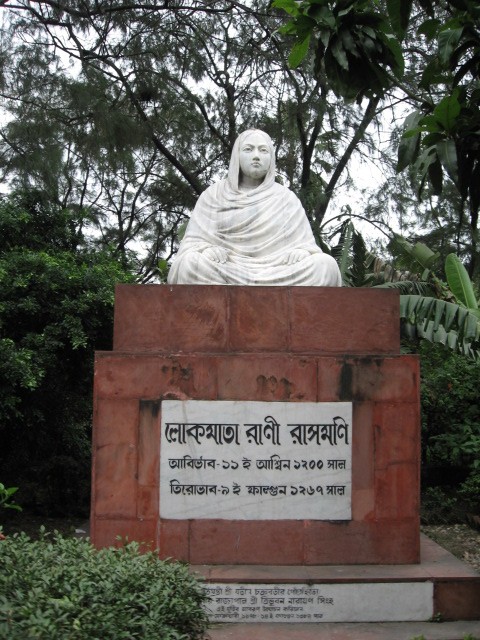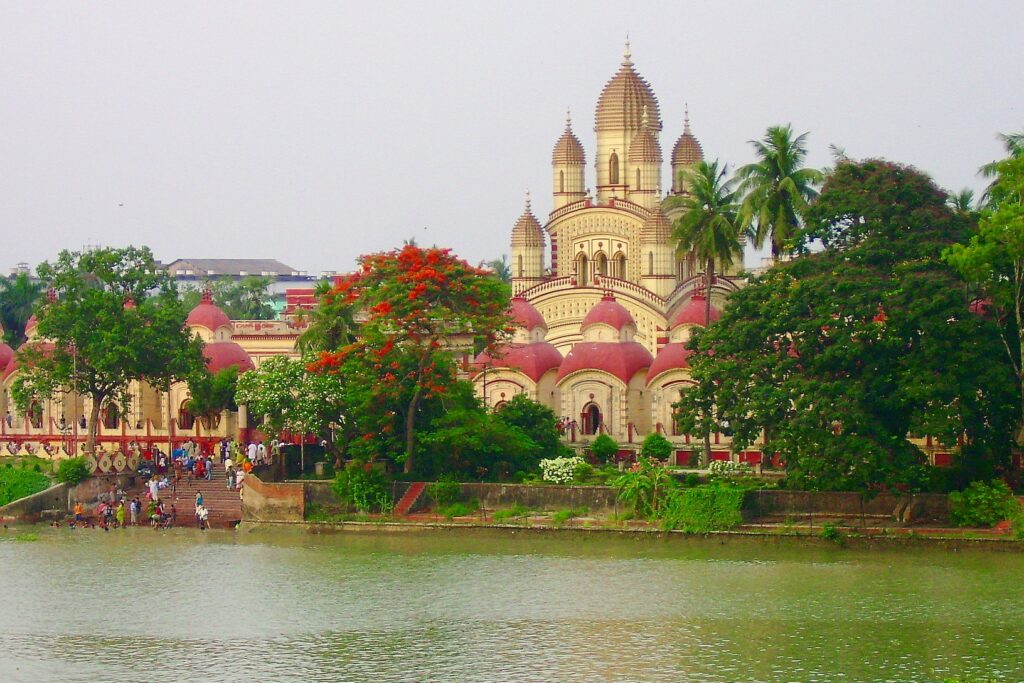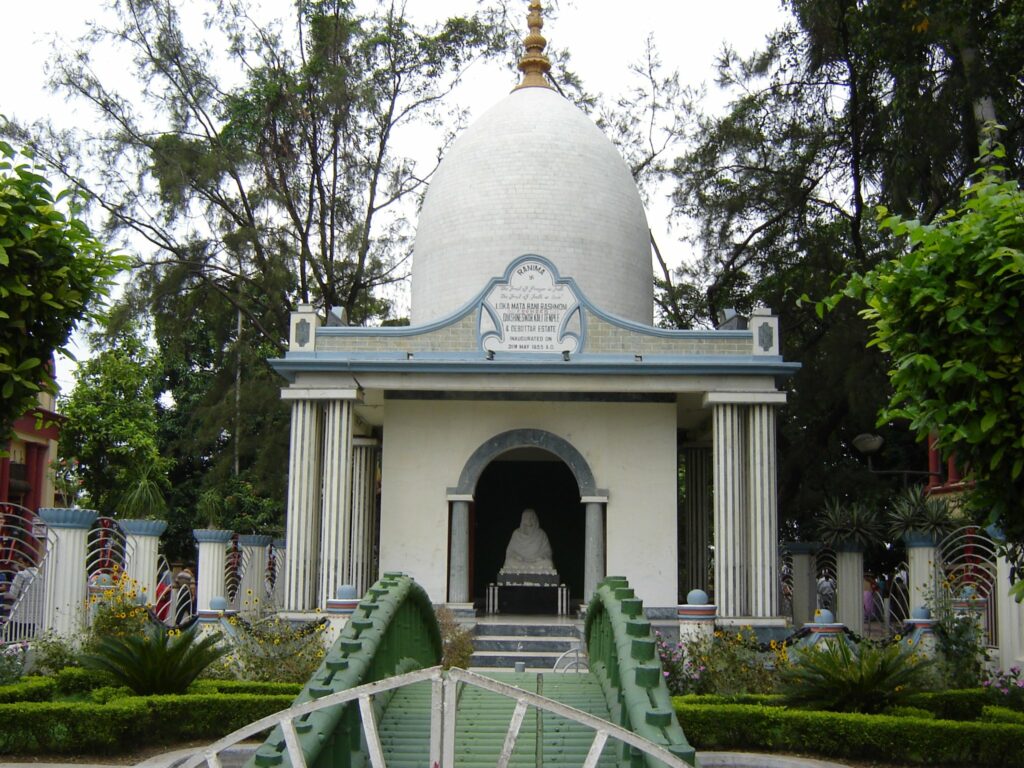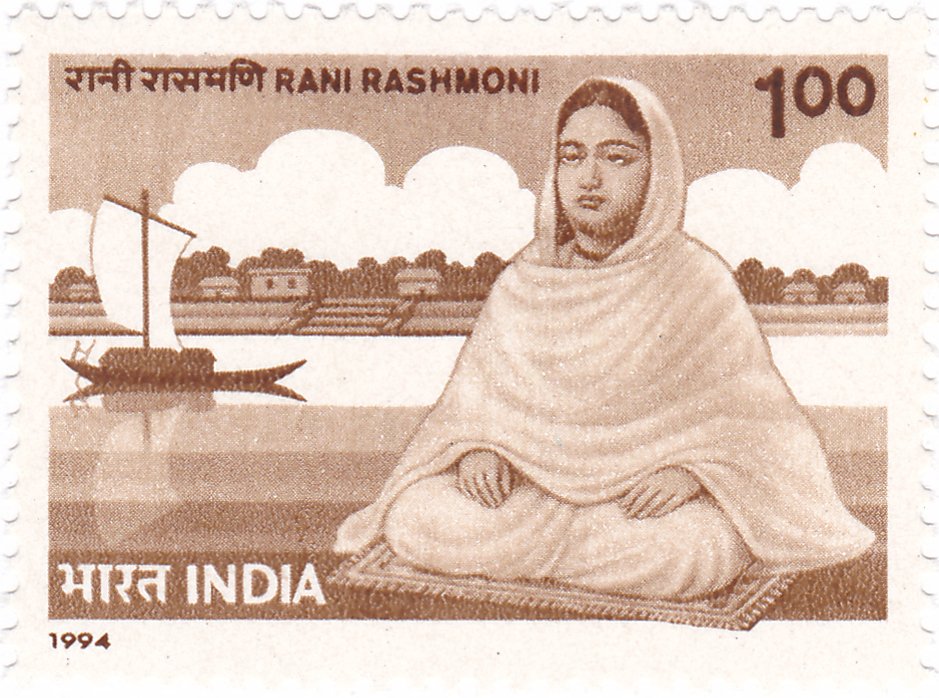- Truthfulness is The Key to God-realization
- “I Am Not a Beggar Monk.”
- “The Road is Mine”
- Rani Rasmani Helping Fishermen
- “Install Me as Soon as Possible.”
- Skillfully Mending The Image of Krishna
- “Even Here You Think Such Thoughts!”
Rani Rasmani (27.9.1793 – 24.2.1861)—Founded the famed temple-complex at Dakshineswar (1855), hallowed by the presence there of Sri Ramakrishna (1855-1885), the sacred site of his legendary spiritual activities. Known for her piety, philanthropy, statesmanship, strong personality and bold confrontations of the British. Born at Kona village in 24 Parganas to very poor parents, Harekrishna Das and Rampriya. Her mother called her Rani and died when she was 7 years old. Barely literate, was married to Rajchandra Das, zamindar of Janbazar (70 and 71 Free School Street) on 23.4.1804 at the age of 11. The third wife of Rajchandra, her arrival augured well for him, the estate coffers being full and he gaining the title “Rai Bahadur” (1833). Public welfare activities undertaken by her included the construction of Babu Ghat and Babu Road (now Rani Rasmani Road). Had four daughters, Padmamani, Kumari, Karunamayee and Jagadamba. After Rajchandra’s death managed the estate with the help of third son-in-law Mathuramohan Biswas, better known as Mathur Babu, who married Jagadamba after the untimely death of Karunamayee. Often went on pilgrimages, spending much money. At Puri offered three diamond-studded crowns to the deities at the Jagannath temple. Planned an elaborate pilgrimage to Varanasi. On the eve of departure the Divine Mother appeared in a dream saying she need not go to Varanasi and asked her to install Her image at a beautiful spot on the bank of the Ganga and arrange for Her worship there (another version has it that after starting the journey, the boats cast anchor near Dakshineswar on the first night and she had the dream there). She cancelled the trip at once.
The Dakshineswar temple complex begun in 1847 took more than 8 years to complete, and 9 lakhs of rupees were spent on it, besides the cost of the land and the embankment. Image of Kali (Bhavatarini) installed and temple consecrated on 31.5.1855. Initial impediments to this, owing to the Rani’s belonging to a low caste, were overcome by the counsel of Ramkumar Chattopadhyay, the Master’s eldest brother, and he was persuaded to accept the post of priest at the Kali temple. Led to Rasmani’s association with Gadadhar and ultimately his appointment as priest upon Ramkumar’s retirement a year later and his death. Unflinching and unquestioning faith of the Rani and Mathur Babu in Gadadhar’s sublime spirituality smoothed the path for Gadadhar to blossom into Sri Ramakrishna Paramahamsa. The ailing Rani passed her last days in her Kalighat residence on the bank of the Ganga. She passed away on 19.2.1861, the day after signing the deed of endowment of her property at Dinajpore for the maintenance of the temples. On the occasion of the centenary of the temple complex a memorial to the Rani was built within the complex with a marble bust of the Rani in front of it. Lately her marble statue has been installed in Calcutta too. Jadu Babu’s bazaar at Bhawanipore was set up by the Rani in the garden-house of Sir Robert Chambers and gifted to her grandson Jadunath Chowdhury, Kumari’s son. The inheritance of the Rani split into numerous portions, the house having several new addresses. Of her daughters Padmamani was married to Ramchandra Ata (Das) of Suresh Sarkar Road, Entally, Kumari to Pyarimohan Chowdhury of Tangra and Karunamayee and Jagadamba to Mathuramohan Biswas of Bithari village in 24 Parganas.
There are several biographies of the Rani by Hemchandra Banerjee, Prabodh Chandra Santra, Bankim Chandra Sen, Ashapurna Devi and others. A Bengali film based on her life was very popular.
——————————-

Rashmoni was born on 28 September 1793 in the small village of Halisahar in Bengal into a kaivarta (fishermen community) family. Her father was a poor labourer, who married his daughter to Raj Chandra Das — the scion of a wealthy zamindar family from Jaan Bazaar — when she was still in her teens.
Das was a progressive husband; educated and unconventional for those archaic times. Impressed by how astute she was, he encouraged his young wife to follow her heart and gave her unfettered access to his trade business.
Together, they built up a great fortune, channelling much of their wealth towards public welfare, from building pyaus (reservoirs of drinking water) for the abandoned to setting up soup kitchens for the hungry. The couple also built two of Kolkata’s oldest and busiest ghats, the Ahiritola Ghat and the beautiful Babu Rajchandra Das Ghat, or Babughat.
However, Das passed away in 1830, and the years after his death saw Rashmoni passing through her toughest time. Battling patriarchy and the then-prevailing societal stigma against widows, the mother of four young daughters took over the reins of the family’s sprawling business – something that was virtually unheard of in those days.
When her husband’s adversaries and acquaintances heard this news, they were delighted by the prospect of an easy takeover, assuming that the kind-hearted widow would not provide much resistance. They would soon learn otherwise.
Displaying astute business sense, Rashmoni fended off these attempts, managing her work with exemplary pragmatism and the help of Mathura Nath Biswas, an educated young man married to her third daughter. For the rest of her life, Mathura babu (as he was called) would remain her trusted confidante and right-hand man in all dealings.
In the years that followed, Rashmoni raised her voice for two important causes — one, to fight against prevalent social ills like polygamy, child marriage and sati; and two, to support trailblazing social reformers like Ishwar Chandra Vidyasagar, even submitting a draft bill against polygamy to the East India Company.
She also built the famous Dakshineswar temple near Kolkata, braving taunts from Brahmins who refused to become priests at a temple constructed by a woman from a lower Shudra caste. Eventually, religious leader Ramakrishna Paramhansa would go on to serve as the Chief Priest of the temple.

While such constructions and business acumen earned her much respect in Calcutta’s administrative circles, it was her compassion and solidarity with the downtrodden that endeared her to the underprivileged.

Sri Ramakrishna on Rani Rashmoni
Sri Ramakrishna once said: “Rani Rasmani was one of the eight nayikas [attendant goddesses] of the Divine Mother. She came down to the world to spread the worship of the Divine Mother.”
Rani Rashmoni’s Daily Routine
Early in the morning she would get up and repeat her mantra in the shrine. Then in mid morning she would sit in her office and sign official documents, appoint officers, check accounts, and discuss various problems and projects with Mathur. At noon she would partake of the food that had been offered to the Lord, and then she would rest. Later in the day, after supervising the office work, she would attend the vesper service. She was fond of inviting brahmin scholars and listening to their discourses on the scriptures.

Final Days of Rani Rashmoni
After the dedication of the temple at Dakshineswar, Rani Rasmani began to spend more and more time in spiritual disciplines. She loved to come to Dakshineswar and talk about God with Sri Ramakrishna and to hear him sing devotional songs. But gradually the time came for her departure from Sri Ramakrishna’s divine drama. In the early part of 1861 Rasmani became sick with a fever and chronic dysentery. The best doctors of Calcutta tried their utmost to cure her, but they at last gave up hope. They then suggested that she be moved to a healthier place. It was Rasmani’s desire to go to her garden house at Kalighat, in South Calcutta, which was on the bank of the Adi Ganga, a small stream flowing into the Ganges.
Rasmani knew that her death was imminent and there was one task that she had left unfinished. The property that she had bought in Dinajpur (now in Bangladesh) as an endowment for the maintenance of the Dakshineswar temple had still not been transferred to the temple trust. She executed the deed of endowment on 18 February 1861, and died the next day (19 February).
Shortly before she passed away she was brought to the bank of the Adi Ganga. Seeing some lamps lighted in front of her, she exclaimed: “Remove, remove these lights. I don’t care for this artificial illumination anymore. Now my Mother has come and the brilliance of Her form has illumined the whole place.”a After a short pause she passed away, saying, “Mother, You have come!”